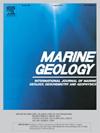智利Coquimbo湾(30°S)近600年海洋和气候变化的重建
IF 2.2
3区 地球科学
Q2 GEOSCIENCES, MULTIDISCIPLINARY
引用次数: 0
摘要
Coquimbo(30°S)外的上升流系统受到El Niño-Southern涛动(ENSO)驱动的年际变率的强烈影响,该变率在暖期(El Niño事件)降低初级生产力并增加降水。本研究基于科金博湾最近的沉积记录,研究了该地区主要海洋学和气候特征的历史变化。在一个沉积岩心(BC117; 83 cm)中,识别出9个沉积单元,并将其划分为2组:u1、u3、u5和u9代表海相沉积,主要为海洋硅藻,δ13C和δ15N值较高,反映了海相条件。相比之下,u4、u6和u7的δ13C值更低,淡水硅藻瓣增加,表明可能受到大陆冲积事件的影响。这些单元显示铁、钾和铜浓度升高,细沉积物含量增加,可能与1700-1730年左右的El Niño-induced强降雨有关。这一时期之后,由于降水减少,大陆投入减少。从1403年到1850年,地核反映了一个以La Niña-like条件为主导的时期,持续了南方涛动指数(SOI)的增强和太平洋年代际涛动(IPO)的减弱。在此期间,海底经历了减少条件的增加,可能导致缺氧环境,随后由于通风过程的增强,在当前暖期(CWP)周围的减少条件较少。然而,越来越多的初级生产力指标表明,近年来上升流加剧。根据这些单元的特征,三次海啸事件的特征是硅藻总数的显著减少,这取决于事件的能量和较低的未受干扰单元与受严重干扰的上覆层之间的急剧基础接触(公元1420年、1471年和1751年)。本文章由计算机程序翻译,如有差异,请以英文原文为准。
Reconstruction of oceanographic and climatic changes over the past ∼ 600 years over Coquimbo Bay, Chile (30°S)
The upwelling system off Coquimbo (30°S) is strongly influenced by interannual variability driven by the El Niño-Southern Oscillation (ENSO), which decreases primary productivity and increases precipitation during the warm phase (El Niño events). This study examined the historical variations in the primary oceanographic and climatic characteristics of the region based on recent sedimentary records from Coquimbo Bay. In a sediment core (BC117; 83 cm), nine sedimentary units were identified and categorized into two groups: u1, u3, u5, and u9 represent marine sedimentation, as indicated by the major contribution of marine diatoms and higher δ13C and δ15N values reflecting marine conditions. In contrast, u4, u6 and u7 exhibited more depleted δ13C values and an increase in freshwater diatom valves, suggesting a significant continental influence, likely from alluvial events. These units showed elevated concentrations of Fe, K, and Cu and an increase in fine sediment content, likely associated with El Niño-induced heavy rainfall around 1700–1730 CE. This period was followed by a decrease in continental input owing to reduced pluviosity. Spanning from 1403 CE to 1850 CE, the core reflects a period dominated by La Niña-like conditions, sustained by an intensified Southern Oscillation Index (SOI) and diminished Interdecadal Pacific Oscillation (IPO). During this period, the seafloor experienced an increase in reduced conditions, likely leading to anoxic environments, which were subsequently followed by less reduced conditions encompassing the Current Warm Period (CWP) due to enhanced ventilation processes. Nevertheless, increasing proxies for primary productivity have suggested an intensification of upwelling in recent times. Based on the characteristics of the units, three tsunami events were characterized by a significant reduction in total diatom counts contingent on the energy of the event and a sharp basal contact between the lower undisturbed unit and the very disturbed overlying layer (1420, 1471, and 1751 CE).
求助全文
通过发布文献求助,成功后即可免费获取论文全文。
去求助
来源期刊

Marine Geology
地学-地球科学综合
CiteScore
6.10
自引率
6.90%
发文量
175
审稿时长
21.9 weeks
期刊介绍:
Marine Geology is the premier international journal on marine geological processes in the broadest sense. We seek papers that are comprehensive, interdisciplinary and synthetic that will be lasting contributions to the field. Although most papers are based on regional studies, they must demonstrate new findings of international significance. We accept papers on subjects as diverse as seafloor hydrothermal systems, beach dynamics, early diagenesis, microbiological studies in sediments, palaeoclimate studies and geophysical studies of the seabed. We encourage papers that address emerging new fields, for example the influence of anthropogenic processes on coastal/marine geology and coastal/marine geoarchaeology. We insist that the papers are concerned with the marine realm and that they deal with geology: with rocks, sediments, and physical and chemical processes affecting them. Papers should address scientific hypotheses: highly descriptive data compilations or papers that deal only with marine management and risk assessment should be submitted to other journals. Papers on laboratory or modelling studies must demonstrate direct relevance to marine processes or deposits. The primary criteria for acceptance of papers is that the science is of high quality, novel, significant, and of broad international interest.
 求助内容:
求助内容: 应助结果提醒方式:
应助结果提醒方式:


